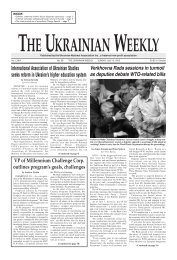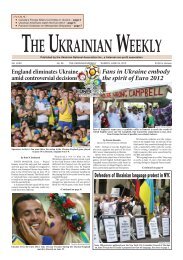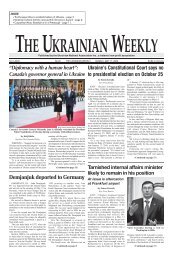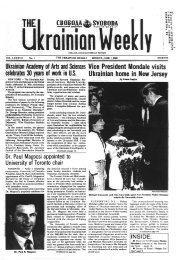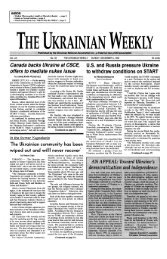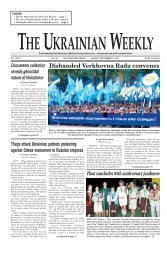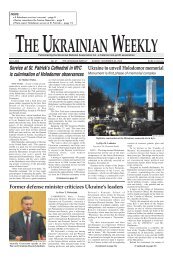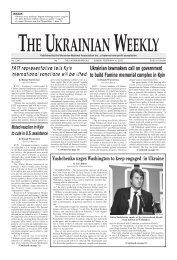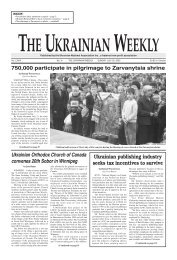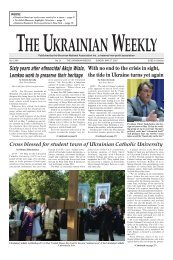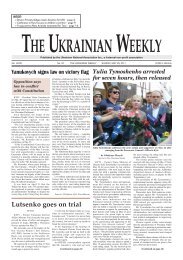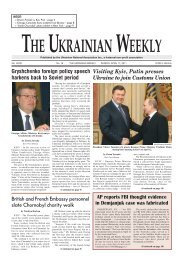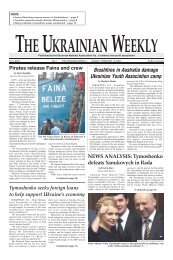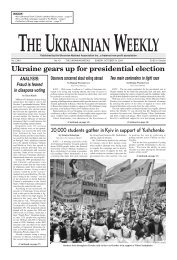1_January 6, 2002 - The Ukrainian Weekly
1_January 6, 2002 - The Ukrainian Weekly
1_January 6, 2002 - The Ukrainian Weekly
You also want an ePaper? Increase the reach of your titles
YUMPU automatically turns print PDFs into web optimized ePapers that Google loves.
10 THE UKRAINIAN WEEKLY SUNDAY, JANUARY 6, <strong>2002</strong><br />
No. 1<br />
2001: THE YEAR IN REVIEW<br />
but the Parliament had been dragging its feet on new legislation,<br />
partly because of fears that their own bootlegged<br />
products would merely be replaced with Russian materials<br />
and partly because the political left did not feel a need<br />
to respond to U.S. demands.<br />
A bill on the matter was voted down by the Verkhovna<br />
Rada on November 22, resulting in renewed threats from<br />
the U.S. to begin sanctions on December 1. <strong>The</strong> deadline<br />
was pushed back to December 12 after a version of a new<br />
bill passed initial review in the Parliament on November<br />
29. After the Parliament failed, twice, to approve the bill<br />
on December 20, the Office of the U.S. Trade<br />
Representative announced that trade sanctions would be<br />
imposed on <strong>January</strong> 23, <strong>2002</strong>.<br />
During 2001 the United States continued to support<br />
the Kharkiv Initiative, a project developed to support the<br />
Kharkiv region after Ukraine agreed in 1999 not to supply<br />
Iran with large turbines for a nuclear power plant.<br />
<strong>The</strong> U.S. continued to promote business exchanges and<br />
support for local entrepreneurial activity.<br />
<strong>The</strong> United States also supplied relief to the<br />
Transcarpathian region after floods devastated the area<br />
early in the spring.<br />
Ukraine responded to the September 11 terrorist attacks<br />
on the U.S. by giving its full support to a global war against<br />
terrorism and becoming part of the alliance. President<br />
Kuchma, while indicating <strong>Ukrainian</strong> soldiers would not<br />
take part in ground action in Afghanistan after the suffering<br />
the <strong>Ukrainian</strong> SSR’s soldiers endured during the Soviet-<br />
Afghan War, did, however, give permission for limited U.S.<br />
access to <strong>Ukrainian</strong> air space for transport of cargo.<br />
<strong>Ukrainian</strong> citizens also expressed deep sympathy and<br />
support for the thousands who perished and for those who<br />
survived the World Trade Center and the Pentagon calamities<br />
by placing scores, if not hundreds, of flowers, bouquets<br />
and handwritten greetings before the U.S. Embassy<br />
in Kyiv in the days immediately following the tragedy.<br />
<strong>The</strong> show of support continued with a requiem concert<br />
at the National Opera House in Kyiv held in accordance<br />
with <strong>Ukrainian</strong> tradition on the 40th day since the tragedy<br />
(October 22) and attended by U.S. Ambassador Carlos<br />
Pascual. <strong>The</strong> Odesa Philharmonic, conducted by<br />
American Earle Hobart, performed. <strong>The</strong>n on December<br />
11, the 90th day since the terrorist act, the U.S. Embassy<br />
sponsored a memorial service at St. Alexander’s Roman<br />
Catholic Cathedral in Kyiv that was attended by representatives<br />
of the international diplomatic community,<br />
<strong>Ukrainian</strong> government officials and <strong>Ukrainian</strong> citizens.<br />
Independent Ukraine<br />
celebrates a decade<br />
Although planning for Ukraine’s 10th anniversary of<br />
independence in some instances began a full year<br />
prior to the celebration and in others even earlier,<br />
the first tangible evidence that the country was gearing up<br />
for a special event occurred with the onset of construction<br />
of Kyiv’s central plaza, Independence Square.<br />
Most plans were centered on the nation’s capital and<br />
the main ones called for a new central square and a renovated<br />
Kyiv central train station, as well as a general<br />
facelift for the city.<br />
Unfortunately, even these preparations for a grand celebration,<br />
like almost everything in the life of Kyiv in<br />
2001 were tainted by events surrounding the disappearance<br />
of the journalist Heorhii Gongadze.<br />
Independence Square was sealed off with a large green<br />
construction wall in late <strong>January</strong> – at least a month earlier<br />
than had been originally planned – when protesters calling<br />
for the removal of President Leonid Kuchma in connection<br />
with the Gongadze affair, began to reassemble a tent<br />
city on the square in mid-<strong>January</strong> after a similar one was<br />
torn down prior to the New Year holiday.<br />
With the walls up, the only glimpse Kyivans had of<br />
what was being done to the country’s symbol of independence<br />
was quick peeks through temporarily open<br />
worker entryways as giant trucks lumbered out.<br />
Plans for the new plaza called for the construction of a<br />
pantheon of <strong>Ukrainian</strong> historical figures on the south side<br />
of the plaza, behind which the new <strong>Ukrainian</strong> Historical<br />
Museum would stand. Rising before the pantheon, at the<br />
center of Independence Square, would be a 60-foot column,<br />
atop which would stand a female-inspired figure<br />
representing “Lady Independence.”<br />
Several small fountains surrounding the remains of the<br />
ancient southern gates to medieval Kyiv were to dominate<br />
the south side of the Khreschatyk. A giant subterranean<br />
shopping mall was planned for beneath the sur-<br />
AP/Viktor Pobedinsky<br />
<strong>The</strong> new monument unveiled in Kyiv on the occasion<br />
of the 10th anniversary of Ukraine’s independence.<br />
face. While the scale of the reconstruction of<br />
Independence Square impressed most people, the project<br />
did not come without controversy.<br />
<strong>The</strong> first hints that problems existed surfaced when an<br />
archaeologist revealed that the architectural plans called<br />
for the destruction of much of the ancient Liadski Gates<br />
buried beneath the square. Mykhailo Zahaiduk said on<br />
April 6, as the old square was being dug up, that city<br />
planners had failed to take adequate measures to ensure<br />
that the remains of the Liadski Gates were not disturbed.<br />
Mr. Zahaiduk, an archaeologist, explained that during<br />
an earlier archaeological excavation his team had discovered<br />
the gates during hurried work at the square when it<br />
was last renovated in 1981 and conducted under tight<br />
deadlines similar to those current work crews had to<br />
meet. At that time the archaeological site was reburied<br />
with the stated intention of properly restoring the site at<br />
some later date.<br />
Mr. Zahaiduk explained that he and his colleagues<br />
believed that new construction plans were such that a<br />
small representative portion of the gate would be preserved<br />
and the rest destroyed and hauled away – something<br />
that he called a crime. <strong>The</strong> group called on city officials<br />
to give archaeologists time to do a proper archaeological<br />
dig to record and preserve the artifacts.<br />
<strong>The</strong> archaeologists lost their battle, and the plans ultimately<br />
did not need to be changed after a dump truck<br />
bumped up against the ancient remains and knocked<br />
them down. Some said it was truly an unfortunate accident,<br />
while some unnamed workers said the incident was<br />
far from inadvertent. As had been envisioned in the original<br />
plans, a portion of the main wall of the Liadski Gates<br />
was preserved and made available for viewing through a<br />
display at the center of the square.<br />
Another disaster – this one with more human costs –<br />
occurred on July 12 when a 60-ton concrete platform collapsed,<br />
badly injuring two workers. <strong>The</strong> accident happened<br />
after a sand slide destabilized the platform, which<br />
was the foundation for the monument to St. Michael the<br />
Archangel that dominated the forward part of the northern<br />
portion of the square. <strong>The</strong> sand slide buried two<br />
workers who were saved by their colleagues who worked<br />
feverishly to uncover them.<br />
By mid-summer, extensive renovation of the central<br />
railroad station was on schedule for completion, as were<br />
facelifts of many city parks, memorials and historical<br />
buildings. With most of the city center dominated by<br />
some sort of reconstruction, traffic snarls and roadblocks<br />
became the norm, which caused more than a little grumbling<br />
by commuters.<br />
Although many had snickered with doubt as to such a<br />
possibility, the city made all its deadlines and everything<br />
was ready on time. Independence Square – dominated by<br />
marble and bleached granite, and the 60-foot pillar with the<br />
green and gilded female figure atop it – opened on August<br />
23. Those present included President Kuchma and his honored<br />
guest, Polish President Aleksander Kwasniewski,<br />
along with an entourage of <strong>Ukrainian</strong> state leaders.<br />
Kyiv Mayor Oleksander Omelchenko, whose stature<br />
as a politician who gets things done continued to climb<br />
with his successful completion of the various projects,<br />
opened the ceremony, which was highlighted by the<br />
release of hundreds of pigeons, a colorful daytime fireworks<br />
display and an exhibition by <strong>Ukrainian</strong> youth and<br />
sports ensembles.<br />
President Kuchma said the new monument on<br />
Independence Square symbolized not only independence,<br />
but “liberty, faith and beauty, respect for human intelligence<br />
and human toil.”<br />
He said the figure also should come to represent the<br />
unity of the various ethnic and religious groupings in the<br />
country.<br />
<strong>The</strong> opening of the square was part of a packed day of<br />
events for the <strong>Ukrainian</strong> president, as 10th anniversary<br />
celebrations began to reach full stride on the eve of the<br />
big day. In the morning the president attended a moleben<br />
at St. Sophia Church, where all of Ukraine’s major religious<br />
confessions were represented. Afterwards he proceeded<br />
to the memorial to St. Volodymyr the Great,<br />
which overlooks the Dnipro River, for another prayer<br />
service and then placed flowers at the monuments to<br />
Ukraine’s national bard, Taras Shevchenko, and its first<br />
president, Mykhailo Hrushevsky.<br />
After lunch Presidents Kuchma and Kwasniewski,<br />
joined by two more state leaders, Vladimir Putin of<br />
Russia and Boris Trajkovski of Macedonia, attended a<br />
jubilee concert at the Ukraina Palace concert hall. Mr.<br />
Kuchma gave a 50-minute discourse on the accomplishments<br />
of the last decade and what still awaits the country<br />
in its transformation to an independent, sovereign and<br />
free-market democracy. <strong>The</strong> concert featured performances<br />
by artists and ensembles representing various<br />
regions and diverse ethnic groups of Ukraine.<br />
<strong>The</strong> previous day, in another highlight of the week’s<br />
commemorations, the same members of the Verkhovna<br />
Rada who had carried a large blue-and-yellow <strong>Ukrainian</strong><br />
flag into the session hall 10 years ago after the lawmakers<br />
voted to leave the Soviet Union and declare an independent<br />
state, re-enacted the historic event to mighty applause<br />
during a ceremonial session of the Verkhovna Rada.<br />
A good portion of the Kyiv diplomatic corps, along<br />
with most of the past and present members of Parliament,<br />
as well as President Kuchma and Prime Minister Anatolii<br />
Kinakh, the Cabinet of Ministers, and the judges of both<br />
the Supreme Court and the Constitutional Court were on<br />
hand to view the proceedings, which included an address<br />
by Chairman Ivan Pliusch.<br />
<strong>The</strong> session also included the reading of a proclamation<br />
– addressed by the Verkhovna Rada to the<br />
Parliaments of the world – by National Deputy Ihor<br />
Yukhnovsky, who in 1991 had headed the caucus of<br />
national deputies that successfully battled for the declaration<br />
of independence.<br />
Events surrounding the 10th anniversary celebrations<br />
had actually begun several weeks before the August 24<br />
date. <strong>The</strong>re were children’s workshops and art festivals<br />
throughout the summer, which were dedicated to independence.<br />
<strong>The</strong> official first day of the central events surrounding<br />
Independence Day was the Third World Forum<br />
of <strong>Ukrainian</strong>s, which opened on August 18 with 600 delegates<br />
and a like number of guests from around the world<br />
in attendance (see diaspora section for full story).<br />
Much controversy surrounded the forum, including the<br />
opening address by President Kuchma, during which he<br />
was heckled extensively by the crowd, and a second presentation,<br />
this one by <strong>Ukrainian</strong> World Congress President<br />
Askold Lozynskyj, which drew hearty applause, at least<br />
from the diaspora portion of the audience.<br />
<strong>The</strong> renowned <strong>Ukrainian</strong> Bandurist Chorus of America<br />
was the center of a lesser debacle when organizers of the<br />
World Forum of <strong>Ukrainian</strong>s jubilee concert demanded<br />
that the group cut its scheduled repertoire of songs. <strong>The</strong><br />
Detroit-based men’s chorus agreed, but only after voicing<br />
displeasure with the changes and the manner in which the<br />
concert was organized.<br />
<strong>The</strong> bandurists performed at several other venues during<br />
what they termed a successful week in Kyiv, including<br />
an Independence Day concert on Mykhailivsky<br />
Square, the Teacher’s Building, the residence of the U.S.<br />
ambassador and St. Michael’s Golden-Domed Sobor.



